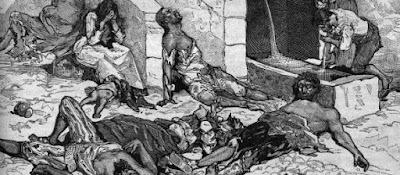Some wanted to situate it in Africa; in fact, if the home-African center, too, very old, it remains secondary and Asian. Until the Christian era, at least forty epidemics shook already succeeded with the Bible, the Iliad and the Aeneid were echoed; most seem to actually have noted other plagues combined under the same term (pestis, plague); and the plague of Athens in 331 before J-C. Was an epidemic of typhus.
Note three great plague pandemic that marked humanity, the Justinian plague, the Black Death and the third pandemic.
FIRST PANDEMIC:
The Justinian plague takes its name from the Byzantine Emperor Justinian, who ruled a large part of the ancient Roman world in the sixth century. Plague of Justinian (seventh century AD), which dominated the bubonic form, and whose ProScope says that it consumed almost all mankind, struck the whole Mediterranean basin, that is to say, the entire known world at the time.Until the eighth century, the epidemic wandered throughout the Mediterranean and France. From 540-767 it returned regularly on French shores of the Mediterranean and along the Rhone, every 9-13 years and then disappeared for no apparent reason.0n lives in it the manifestation of revenge or of divine wrath, God no longer supports the sins of men, he had to urge his clemency, to 'repentance' and ask the Virgin and the saints to intercede with him appease his ire '. Thus, they particularly prayed San Sebastian for the first time in Rome in 680.
We can also use all kinds of superstitions until we understand that the isolation and restriction on movement were the best obstacles to evil. Then Europe knew a long break until the middle of the fourteenth century. It can, therefore, be considered as the first plague pandemic.
THE GREAT PLAGUE OF THE MIDDLE AGES (PANDEMIC SECOND):
Great Plague or Black Death, the epidemic that ravaged Europe from 1348, and resurfaced several times until the late fourteenth century.Appeared in Central Asia, it reached the port of Marseilles in 1347 and spread throughout most of the continent over the next four years, decimating nearly a third of the population by his contemporaries (Jean Froissart). Part of Central Asia in 1330 years, the Great Plague or Black Death soon spread:
- in China
- In India, following the trade routes.
At the end of 1347, contaminated rats infecting the holds of merchant ships, the disease wins Marseille, (Quickly) Avignon, the city of the Popes since 1309 and center of the Christian world. The next year: The entire French territory, Spain, Southern England, Italy, The Balkans.
- In 1349, the rest of Europe (with the exception of Bohemia, Hungary and Poland large pockets in the Béarn and Flanders) are achieved.
The highly concentrated population groups, armies, monasteries, and cities are particularly affected, while some cities such as Milan and Nuremberg, miraculously spared. In addition, plague unequally affects different population groups. The urban proletariat, already weakened by misery and want, paying a heavy price. The aristocracy and the bourgeoisie, who are better fed and have better health conditions, are preferred address this scourge. They have, moreover, the opportunity to flee the progression of the epidemic. The less densely populated areas, particularly rural areas, are also more spared. Cities are decertified one after the other, medicine of the time has neither the knowledge nor the capacity to stop epidemics. The population at the time the epidemic sees a manifestation of divine wrath. With no medical remedy, it is won by renewed Christian fervor. A vast movement of punishment and flagellants grows throughout Europe. Some communities used as scapegoats, like Jews. Accused of poisoning, they undergo genocide, particularly in Spain and Germany (2000 executions in Strasbourg in February 1349).
Nearly 25 million people have died of the plague, the proportion of deaths to nearly half the population in some countries, like France.
In the long term, the epidemic has significantly accelerated population decline began early this century, mainly because of its recurrence (1360, 1369, 1375, etc.) and its impact in the younger population groups. The disease remains endemic until the eighteenth century: the last great manifestation of the Western Black Death date 1720-1722 and is known under the name of "Marseille plague". From an economic standpoint, the Great Plague brings medieval Europe in a recession, due to labor shortages, reduced consumption and return hitherto uncultivated vast cultivated areas.
These troubled times also influence in the arts: painting is moving towards more lugubrious themes, full of supernatural.
PANDEMIC THREE:
It begins with the awakening of the old home of Yunnan and won Hong Kong in 1894. This is where Alexandre Yersin discovered in rats and humans, the disease agent which 4 years later showed the PL Simond transmission by the chip.Infected rats and fleas which there was no reference in the first two pandemics would find in steam navigation an excellent means of propagation. Route of the evolution of the plague: Part of Bombay in 1896, plague Suez reached the following year, Madagascar in 1898, Alexandria, Japan, East Africa and Portugal in 1899, Manila, Sydney, Glasgow and San Francisco in 1900, Honolulu in 1908, Java in 1911, Ceylon en1914, Marseille in 1920. In parallel to this invasion by sea, other former homes woke up:
Manchuria in 1910 (about 50 000 died of the pneumonic plague outbreak in three months. India from 1898 to 1948 (over 12 million deaths), Europe (1 thousand cases), the major part of Portugal and a hundred in Paris from 1918-1920.The absence of pulmonary symptoms and the establishment of a rational prophylaxis simultaneously helped to limit the epidemic.





























No comments:
Post a Comment